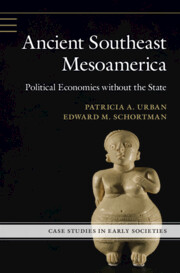Book contents
- Ancient Southeast Mesoamerica
- Case Studies in Early Societies
- Ancient Southeast Mesoamerica
- Copyright page
- Dedication
- Contents
- Figures
- Acknowledgments
- 1 Ways of Understanding Southeast Mesoamerica
- 2 Power, Hierarchy, and Social Differentiation
- 3 Early Arrivals, Domestication, and Emerging Sociopolitical Complexity in Southeast Mesoamerica (10,000 (?)–400 BCE)
- 4 Reformulating Social Networks through the Novel Uses of Things (400 BCE–CE 200)
- 5 The Arrival of Divine Lords
- 6 The Copán Realm, Its Colonies and Allies (CE 600–800)
- 7 The End of Days
- 8 Concentrating Power and Building Hierarchy beyond the Copán-Centered Network (CE 600–800)
- 9 Concentrating Power in the Terminal Classic beyond Copán (CE 800–1000)
- 10 Power and Political Economy in the Late Classic Naco and Middle Chamelecón Valleys (CE 600–800)
- 11 Hierarchy to Heterarchy in the Terminal Classic Naco and Middle Chamelecón Valleys (CE 800–1000)
- 12 Contrasting Forms of Complexity
- 13 Contesting for Power, Challenging Hierarchy, Making History
- References
- Index
13 - Contesting for Power, Challenging Hierarchy, Making History
Published online by Cambridge University Press: 02 April 2024
- Ancient Southeast Mesoamerica
- Case Studies in Early Societies
- Ancient Southeast Mesoamerica
- Copyright page
- Dedication
- Contents
- Figures
- Acknowledgments
- 1 Ways of Understanding Southeast Mesoamerica
- 2 Power, Hierarchy, and Social Differentiation
- 3 Early Arrivals, Domestication, and Emerging Sociopolitical Complexity in Southeast Mesoamerica (10,000 (?)–400 BCE)
- 4 Reformulating Social Networks through the Novel Uses of Things (400 BCE–CE 200)
- 5 The Arrival of Divine Lords
- 6 The Copán Realm, Its Colonies and Allies (CE 600–800)
- 7 The End of Days
- 8 Concentrating Power and Building Hierarchy beyond the Copán-Centered Network (CE 600–800)
- 9 Concentrating Power in the Terminal Classic beyond Copán (CE 800–1000)
- 10 Power and Political Economy in the Late Classic Naco and Middle Chamelecón Valleys (CE 600–800)
- 11 Hierarchy to Heterarchy in the Terminal Classic Naco and Middle Chamelecón Valleys (CE 800–1000)
- 12 Contrasting Forms of Complexity
- 13 Contesting for Power, Challenging Hierarchy, Making History
- References
- Index
Summary
This summary chapter focuses on the tensions that characterized the political histories of Southeast Mesoamerica. At the heart of these contradictions are the majority’s strategies to protect their autonomy in the face of those who sought to centralize power and build hierarchy by promoting the rank and file’s dependence on them for essential goods, symbols, and practices. Schemes to concentrate power by reconfiguring extant social nets and the movement of resources through them were met by countermeasures of the intended victims, who redirected needed assets to their projects by working within social networks of their own making. Oscillations between centralizing and decentralizing tendencies occurring at multiple scales resulted from these contests. Shifts in the availability of resources among competitors presented opportunities for the formation of new political arrangements comprised of novel social webs enacted through unprecedented practices. Thus, as diverse agents sought their often contradictory aims, assets derived from multiple origins came to constitute the lives of people of all ranks living across wide swaths of Southeast Mesoamerica.
- Type
- Chapter
- Information
- Ancient Southeast MesoamericaPolitical Economies without the State, pp. 313 - 337Publisher: Cambridge University PressPrint publication year: 2024

